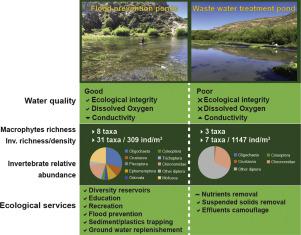当前位置:
X-MOL 学术
›
Ecol. Eng.
›
论文详情
Our official English website, www.x-mol.net, welcomes your feedback! (Note: you will need to create a separate account there.)
Engineered ponds as environmental and ecological solutions in the urban water cycle: A case study in Patagonia
Ecological Engineering ( IF 3.8 ) Pub Date : 2020-07-01 , DOI: 10.1016/j.ecoleng.2020.105915 L.M. Manzo , L.B. Epele , C.N. Horak , A.M. Kutschker , M.L. Miserendino
Ecological Engineering ( IF 3.8 ) Pub Date : 2020-07-01 , DOI: 10.1016/j.ecoleng.2020.105915 L.M. Manzo , L.B. Epele , C.N. Horak , A.M. Kutschker , M.L. Miserendino

|
Abstract Environmentally sound solutions such as engineered ponds have primarily been established for waste water treatment and flood control in urban areas. However, there is a lack of comprehensive understanding of the factors that influence the aquatic biodiversity of these artificial water bodies, and it has been questioned whether ponds that are designed for water treatment are also able to enhance or support regional biodiversity. The present study (1) examined the water management function of two constructed wetland systems in the urban water cycle: flood prevention ponds (FP) and waste water treatment ponds (WT); (2) analyzed their role to enhance local and regional biodiversity (macrophytes and invertebrates); and (3) assessed the functioning of a waste water treatment plant (WTP) in view of regional regulations. As expected, strong differences were found in water quality conditions between FPs and WTs, mostly in terms of nutrients, conductivity, suspended solids and oxygen levels. FPs created optimal environments harboring several species of macrophytes and supporting diverse invertebrate assemblages, comparable to those recorded at natural ponds. On the contrary, WTs sustained three times less taxa, with Psychoda sp. and Chironomus sp., (dipterans indicators of poor ecological conditions) dominating the assemblage. The waste water treatment plant was partially successful with regards to domestic effluent processing. Nutrient values for treated effluents exceeded the permissible standards for receiving surface waters in the region. Constructed ponds offer an opportunity for managers and environmental regulators to conserve and enhance aquatic biodiversity in ecologically poor environments. In addition to other ecosystem services (sociocultural), FPs also promoted biotic biodiversity. WTs functioned as nutrient sinks rather than as biodiversity spots, but their biodiversity and functioning could be enhanced through proper design and management. Some feasible solutions to improve WTP functioning are itemized and discussed.
中文翻译:

工程池塘作为城市水循环中的环境和生态解决方案:巴塔哥尼亚的案例研究
摘要 环境无害的解决方案,如工程池塘,主要用于城市地区的废水处理和防洪。然而,对影响这些人工水体水生生物多样性的因素缺乏全面的了解,设计用于水处理的池塘是否也能够增强或支持区域生物多样性一直受到质疑。本研究 (1) 研究了城市水循环中两种人工湿地系统的水管理功能:防洪池 (FP) 和废水处理池 (WT);(2) 分析它们在增强当地和区域生物多样性(大型植物和无脊椎动物)方面的作用;(3) 根据地区法规评估污水处理厂 (WTP) 的运行情况。正如预期的那样,FP 和 WT 之间的水质条件存在很大差异,主要是在养分、电导率、悬浮固体和氧气水平方面。FPs 创造了最佳环境,其中包含多种大型植物并支持多种无脊椎动物组合,与天然池塘中记录的环境相当。相反,WTs 的分类群减少了三倍,Psychoda sp。和摇蚊 sp.,(恶劣生态条件的双翅目指标)在该组合中占主导地位。该废水处理厂在处理生活污水方面取得了部分成功。处理过的污水的营养价值超过了该地区接受地表水的允许标准。人工池塘为管理者和环境监管者提供了在生态恶劣的环境中保护和增强水生生物多样性的机会。除了其他生态系统服务(社会文化)外,FPs 还促进了生物多样性。WTs 起到养分汇的作用,而不是生物多样性点,但它们的生物多样性和功能可以通过适当的设计和管理来增强。列举并讨论了一些改进 WTP 功能的可行解决方案。
更新日期:2020-07-01
中文翻译:

工程池塘作为城市水循环中的环境和生态解决方案:巴塔哥尼亚的案例研究
摘要 环境无害的解决方案,如工程池塘,主要用于城市地区的废水处理和防洪。然而,对影响这些人工水体水生生物多样性的因素缺乏全面的了解,设计用于水处理的池塘是否也能够增强或支持区域生物多样性一直受到质疑。本研究 (1) 研究了城市水循环中两种人工湿地系统的水管理功能:防洪池 (FP) 和废水处理池 (WT);(2) 分析它们在增强当地和区域生物多样性(大型植物和无脊椎动物)方面的作用;(3) 根据地区法规评估污水处理厂 (WTP) 的运行情况。正如预期的那样,FP 和 WT 之间的水质条件存在很大差异,主要是在养分、电导率、悬浮固体和氧气水平方面。FPs 创造了最佳环境,其中包含多种大型植物并支持多种无脊椎动物组合,与天然池塘中记录的环境相当。相反,WTs 的分类群减少了三倍,Psychoda sp。和摇蚊 sp.,(恶劣生态条件的双翅目指标)在该组合中占主导地位。该废水处理厂在处理生活污水方面取得了部分成功。处理过的污水的营养价值超过了该地区接受地表水的允许标准。人工池塘为管理者和环境监管者提供了在生态恶劣的环境中保护和增强水生生物多样性的机会。除了其他生态系统服务(社会文化)外,FPs 还促进了生物多样性。WTs 起到养分汇的作用,而不是生物多样性点,但它们的生物多样性和功能可以通过适当的设计和管理来增强。列举并讨论了一些改进 WTP 功能的可行解决方案。



























 京公网安备 11010802027423号
京公网安备 11010802027423号